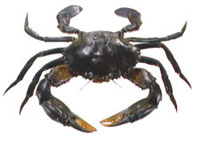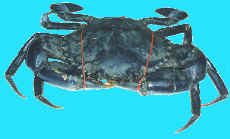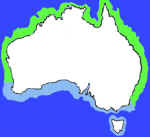|
|
|
|
|
Directory & Info for
Fishing,
Angling, Fishing Tackle, Fishing Guides, Fly Fishing, Bass Fishing,
Sports fishing, Game Fishing....
Info on All types of
Fishing | Angling | Fishing Tackle etc. |
| |
|
Glossary of Fish, Seafood and Fishing Terms |
|
|
|
Australian Fish Bag Limits and Size Regulations |
|
Photos of Australian Seafood, Fish, Crustaceans &
Cephalopods and Information on each... |
|
Abalone, Blacklip |
|
Albacore
Tuna |
|
Baler Shell |
|
Barbounia, Tiny |
|
Barracouta |
|
Barramundi |
|
Bass, Sea |
|
Batfish |
|
Batfish, Silver |
|
Blackfish |
|
Boarfish |
|
Bonito Tuna |
|
Bonito, Watson's Leaping |
|
Bream |
|
Bream, Butter |
|
Bream, Slate |
|
Bug, Moreton Bay
(Slipper Lobster) |
|
Bug, Balmain |
|
Butterfish |
|
Calamari,
Southern |
|
Carp, European |
|
Catfish, Blue |
|
Catfish, Lesser Salmon |
|
Cockles |
|
Cod, Bar |
|
Cod, Blue eye |
|
Cod, Coral Rock |
|
Cod, Ghost |
|
Cod, Maori |
|
Cod, Murray
|
|
Cod, Southern Rock |
|
Cod, Spotted |
|
Cod, Tomato |
|
Cod, Wirrah |
|
Cod, Yellow Spotted |
|
Coral Trout |
|
Cowanyoung |
|
Crab, Blue Swimmer |
|
Crab, Champagne |
|
Crab, Giant
|
|
Crab, Mud |
|
Crab, Spanner |
|
Crawfish |
|
Cuttlefish |
|
Dart Fish |
|
Dolphin Fish |
|
Dory, John |
|
Dory, Mirror |
|
Dory, Silver
|
|
Drummer, Southern |
|
Eel, Longfin |
|
Emperor, Red |
|
Emperor, Red Throat |
|
Flathead |
|
Flounder, Small Toothed |
|
Flutemouth, Rough |
|
Frost Fish |
|
Garfish |
|
Gemfish |
|
Goatfish |
|
Grouper |
|
Gurnard, Red |
|
Gurnard, Spotted |
|
Hairtail |
|
Hump Headed
Maori Wrasse |
|
Hussar |
|
Jackass Fish |
|
Jacket, Ocean |
|
Jacket, Sea |
|
Jewfish |
|
Jobfish, Gold Banned |
|
Jobfish, Rosy |
|
Kingfish,
Yellowtail |
|
Latchet Fish |
|
Leatherjacket, Reef |
|
Ling |
|
Lobster Eastern
Rock |
|
Lobster Southern Rock |
|
Long Tom |
|
Luderick |
|
Mackeral, Jack |
|
Mackerel, Slimey |
|
Mado |
|
Mahi Mahi |
|
Mangrove Jack |
|
Marlin, Black |
|
Marlin, Blue |
|
Marlin, Striped |
|
Melon Shell |
|
Monkfish |
|
Mono |
|
Moon Fish |
|
Morwong |
|
Morwong, Red |
|
Mullet - Roe |
|
Mullet, Diamond Scale |
|
Mullet, Red |
|
Mullet, Sea |
|
Mullet, Yelloweye |
|
Mulloway |
|
Mussels Black |
|
Mussels Greenlip |
|
Nanygai |
|
Octopus |
|
Orange Roughy |
|
Oreo, Black |
|
Oyster,
Native |
|
Oyster,
Pacific |
|
Oyster, Sydney Rock |
|
Parrot Fish |
|
Parrot Fish (2) |
|
Perch, Ocean |
|
Perch, Saddle Tail Sea |
|
Perch, Silver |
|
Perch, Splendid |
|
Perch, Stripey Sea |
|
Pig Fish |
|
Pike |
|
Pineapple Fish |
|
Prawn, Banana |
|
Prawn, King |
|
Prawn, Red Spot |
|
Prawn, School |
|
Prawn, Tiger |
|
Queenfish, Needleskin |
|
Rainbow Runner |
|
Redclaw Crayfish |
|
Redfish |
|
Ribaldo |
|
Ribbon Fish |
|
Rudder Fish |
|
Salmon, Atlantic |
|
Salmon, Australian |
|
Scad |
|
Scallops,
Queensland |
|
Scallops, Tasmanian |
|
Scorpion Fish, Raggy |
|
Shark |
|
Shark Black Tip |
|
Shark, Blue |
|
Shark Bronze Whaler (Dusky) |
|
Shark, Bull |
|
Sharks Fins |
|
Shark, Gummy |
|
Shark, Mako |
|
Shark, School |
|
Shark,
Tiger |
|
Shark,
Whiskery Reef |
|
Shark, White |
|
Shrimp, Mantis |
|
Sicklefish |
|
Silver Biddy |
|
Snapper |
|
Snapper, Big Eye |
|
Snapper, Fry Pan |
|
Snapper, Gold Band |
|
Snapper, King |
|
Snapper,
Red |
|
Snapper, Red Tropical |
|
Sole |
|
Sole, Tongue |
|
Squid, Arrow |
|
Squirrel Fish |
|
Stargazer |
|
Stingray, Butterfly |
|
Stripey Sea
Perch |
|
Surgeonfish, Sixplate Sawtail |
|
Sweetlip, Slatey |
|
Sweetlip, Yellow |
|
Swordfish |
|
Tailor |
|
Tarwhine |
|
Tilefish,
Pink |
|
Trevally, Big Eye |
|
Trevally, Golden |
|
Trevally, Silver |
|
Triple Tail |
|
Trout |
|
Trumpeter, Striped |
|
Tuna,
Albacore |
|
Tuna, Bigeye |
|
Tuna, Bluefin |
|
Tuna, Longtail |
|
Tuna, Skipjack |
|
Tuna, Striped |
|
Tuna, Mackerel |
|
Tuna, Yellowfin |
|
Venus Tusk Fish |
|
Whiting, Sand |
|
Whiting, School |
|
Wrasse |
|
Yabby,
Freshwater Crayfish |
|
Yellowtail |
|
FULL LIST of Fish &
Seafood |
|
Beche De Mer
(Sea Cucumber - Trepang) |
|
Amberfish |
|
Blackfish |
|
Black Teatfish |
|
Brown Sandfish |
|
Curryfish |
|
Elephants Trunks fish |
|
Greenfish |
|
Lollyfish |
|
Pinkfish |
|
Prickly Redfish |
|
Sandfish |
|
Stonefish |
|
Surf Redfish |
|
White Teatfish |
|
|
|
Commercial
Seafood Directory |
|
Sea-Ex Seafood, Fishing, Marine
Directory |
|
Aquaculture Directory |
|
Seafood
Trading Board |
|
Commercial Fishing |
|
Seafood Information by
Country |
|
Australian Fish Photos &
Info |
|
Interesting Fish Facts & Trivia |
|
Country Directories |
|
Thailand Business
Directory |
|
Seafood: |
|
Wholesale Seafood
Suppliers Australia |
|
Wholesale Seafood
Suppliers International |
|
Retail Seafood Sales |
|
Seafood Restaurants |
|
Seafood Recipes |
|
Seafood Information |
|
Seafood
Industry Resources |
|
Mud Crab (Scylla
serrata) Photographs
and Information
|
Mud Crab is also known as
Mangrove Crab, Muddy and Black Crab.
Mud crabs are large crabs with a smooth, broad carapace. They have 9
even sized teeth on each side of their eyes. Their two hind legs are flattened for
swimming. In the most common form, the colour varies from very dark brown to mottled
green. The other, generally smaller form has a deeper body and is reddish brown.
There are four species of
mud crab in the world - Scylla serrata, Scylla tranquebarica,
Scylla paramamosain and Scylla olivacea
Australian Mud Crab
species are Scylla serrata (Green Mud Crab) and Scylla
olivacea (Orange or Brown Mud Crab)
In Australia, mud crabs inhabit tropical to warm temperate waters from
Exmouth in Western Australia up and around to the Bega River in southern New South Wales.
Mudcrabs inhabit sheltered estuaries, the tidal reaches of some rivers,
mud flats and mangrove forests, although females carrying eggs are present in deeper
waters up to 50 kilometres offshore. These crabs favour a soft, muddy bottom, often
below low tide level.
Mating occurs when the female mud crab is in the soft-bodied condition
following moulting. Female mud crabs in Australian populations migrate offshore to
spawn and are rarely seen. 2 to 8 million eggs are produced in each spawning.
Female crabs incubate the eggs for 2 to 4 weeks under their abdominal flap.
For more information on the cycle of the Mudcrab
click here PDF
format
Mud crabs mate in warmer
months. Mature females release a ‘pheromone’ (chemical
attractant) into the water to attract males. Once paired, the
successful male climbs on top of the female, clasps her with his
hind legs, picks her up and carries her around for up to four
days. He releases her when she begins to moult. After she has
shed her shell, he turns her upside down to mate.
Mud crabs live for up to 3 years.
 Juvenile mud crabs eat planktonic animals, benthic molluscs and
crustaceans of various types. Adults feed at night on a variety of bivalve and gastropod
molluscs including mussels,
pipies, small crabs and polychaete worms. Mud crabs are also attracted to dead fish
and meat in traps. The mud crab's large claws are used for crushing and cutting
their prey. If they lose a claw, they may grow another one in successive moults. Juvenile mud crabs eat planktonic animals, benthic molluscs and
crustaceans of various types. Adults feed at night on a variety of bivalve and gastropod
molluscs including mussels,
pipies, small crabs and polychaete worms. Mud crabs are also attracted to dead fish
and meat in traps. The mud crab's large claws are used for crushing and cutting
their prey. If they lose a claw, they may grow another one in successive moults.
How a Crab Sheds its
shell or "Moults":
A crab’s growth isn’t continuous, but results from a series of
moults that happen when it reaches the size of its current
shell. Moulting is triggered by hormones. A new ‘cuticle’ (hard
protective layer) is secreted under the old shell. The crab
rapidly absorbs water, splitting its shell along suture lines,
then backs out of the old shell. Substances stored within the
crab’s body are rapidly redeposited to harden the new cuticle
into a larger shell. The fluid in the body is replaced with meat
during a period when the crab feeds voraciously.
Don't take home a crab
that has recently moulted their shell if you want a lot of meat!
For a Meaty crab choose one that has a shell with maybe some
scaring or algae growth, blunt teeth on their claws and if you
gently press the shell, there should be no movement.
Natural predators of mud crabs include sharks, crocodiles, turtles, rays, large fish such as rock cods and barramundi.
Mud Crabs are caught in wire mesh pots baited with meat or fish.
Mudcrabs are also a bycatch of the coastal set gillnet fishery for barramundi and
threadfin salmon.
Live mudcrabs are sold on the local markets and also exported.
Minimum size applies in all states. Females in berry (with eggs) are
protected in New South Wales and all females are protected in Queensland and Western
Australia.
Did you know?
A female crab is called a Jenny.
A male crab is called a Buck.
Did you know?
Crabs have blue blood, Worms have green blood, and Starfish have
clear
blood.
|
 |
 |
|
|
| Scientific Name |
Scylla serrata |
| Location |
WA, NT, QLD, NSW |
| Season |
All year round |
| Size |
To 3.5 kg |
| Australian Species Code |
28 911902 |
| Taste, Texture |
Delicate sweet taste. Medium to firm texture. |
|
Nutritional Information
For every 100 grams raw product
for Crab meat. |
| Kilojoules |
na |
| Cholesterol |
58 mg |
| Sodium |
na |
| Total fat
(oil) |
0.9 g |
| Saturated
fat |
22% of total
fat |
|
Monounsaturated fat |
20% of total
fat |
|
Polyunsaturated fat |
57% of total
fat |
| Omega-3, EPA |
137 mg |
| Omega-3, DHA |
90 mg |
| Omega-6, AA |
86 mg |
|
|
|

Catching and Fishing for Mud
Crabs:
Mud crabs are typically caught using dillies,
or pots, with the latter being the most popular device. What bait to
use to catch Mud Crabs - The correct bait is essential if you want
to get good results. Where to place your Crab Pots or Traps - Mud
crabs are abundant in a wide range of aquatic habitats, ranging from
the upper reaches of estuaries to coastal mud flats and trenches.
Most estuarine areas fringed with mangroves and/or mud flats will
contain mud crabs.
|
|
Cooking
Mud Crab:
Mud Crabs
are also swimmer Crabs, are found mainly
on the muddy bottoms of shallow coastal mangroves. They have large front legs and developed claws and generally weigh
500g-1kg. They’re mostly sold live (as they can live out of water for days) but
are also available cooked. It is best not to buy dead uncooked Mud Crabs as it’s
difficult to determine their quality. They yield about 25% meat, largely from
the front claws, and are high priced with sweet flesh that has a slightly
stronger flavour and firmer texture than that of other Crabs.
|
|
Commercial Fishing for Mud Crabs: Mud crabs are harvested by professional fishers
throughout the Queensland coast from Southport to Karumba, and generate almost
$10 million in wharf value to the States economy. Mud crabs are sold mostly as
an icon species to the tourist and restaurant trade.
Many commercial crab fishers work from remote, rudimentary land-based camps,
although some access remote waters using mother-ships or permanently-moored
pontoons. Crabbers may travel more than 100 km to set their pots and then stay
in the same area for a number of days before returning to their base to unload
the catch.
Photos of Mud Crabs:
Identifying male and female crab illustration, cooked mud
crab, live green mud crab tied up, photo showing face of a mud crab, cooked mud
crabs prepared for entree
See Also:
Crab,
3
Spot Crab,
Blue Swimming Crab,
Brown
Crab,
Common Swimming Crab,
Dungeness Crab,
Jonah
Crab,
King Crab,
Sea Crab,
Snow Crab,
Softshell Crab,
Spanner Crab,
Spider
Crab,
Stone
Crab,
Velvet
Crab,
Canned Crabmeat
|
|